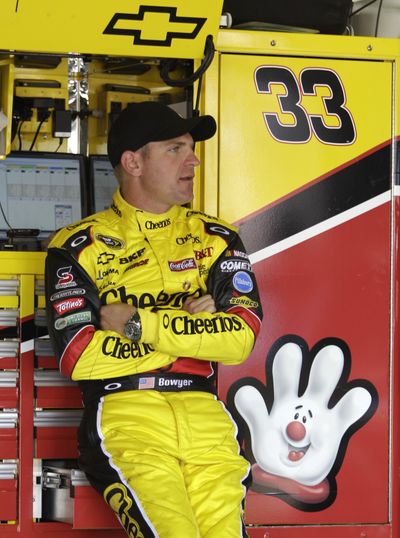Expect plenty of radio chatter at Talladega

TALLADEGA, Ala. – Some compare it to trying to land a date for the prom. Really, it’s just two parties haggling over a potentially lucrative business deal.
Only in this case, the negotiations are taking place at nearly 200 mph.
Drivers who usually only talk to their crew chiefs, spotters and perhaps a teammate will be chatting it up with a bunch of guys they’re trying to beat during Sunday’s restrictor-plate race at Talladega Superspeedway, all looking for someone to go along with a one-car-leads, one-car-pushes, then-we’ll-switch arrangement.
“There will be a lot of pleading, a lot of begging,” Clint Bowyer said.
At Talladega and Daytona, the two NASCAR tracks where horsepower is limited by devices that keep speeds from getting out of hand, teams have learned that two cars paired together can go much faster than drafting in a larger pack, which used to be the norm on these big triovals.
One car runs out front with another right on his bumper, shoving him along. After a few laps, they must switch positions to keep the pusher from overheating his engine. During practice sessions on a gloomy, windy Friday, that’s about all anyone worked on: running in tandem and perfecting the all-important switch.
Those tactics will be crucial in the Sprint Cup race. But the more intriguing subplots can only be heard, not seen, as drivers flip from one channel to another on their radios, looking for a partner during the ebbs and flows of a typical race.
Offers will be made.
Agreements reached.
Whoever plays “Let’s Make A Deal” the best is likely to take the checkered flag in the Aaron’s 499.
“It’s going to be interesting at the end of this thing,” Bowyer said. “It will be quite humorous.”
He wasn’t laughing at the Daytona 500. After working much of the race with teammate Jeff Burton, Bowyer had to make alternate arrangements when the No. 31 car blew its engine. He worked out a deal with Kyle Busch, but couldn’t find him on the radio.
“We couldn’t communicate as good with one another the way we would have liked. If we could have, the outcome would have been a lot better,” said Bowyer, who finished 17th, while Busch settled for eighth. “You just go through (the channels) and say, ‘Is this Kyle?’ and they say, ‘No, get off my radio!’ And you say, ‘Hello, is this Kyle,’ and you just keep switching ’til you find him.”
He never did, forcing them to pass messages to each other through their respective spotters. That was no match for guys who were talking directly to each other on the radio, allowing them to make split-second decisions.
“It was complete chaos,” Bowyer said. “Now, you are able to switch over and tell him. You don’t have to go through two spotters and wait for the response and then get back and then, by the way, you missed your opportunity and we are no longer leading the race because somebody else was talking and did it way better than you did.”
For those outside the sport, this must all seem a little strange.
Just imagine NFL coach Bill Belichick on his headset, going over strategy with his counterpart on the opposite sideline.
But the drivers say it’s a safety issue, necessitated by this new style of racing. The driver of the car that’s pushing can’t see anything except the machine on his front bumper. If anything happens in front of a tandem, it’s imperative they’re able to communicate.